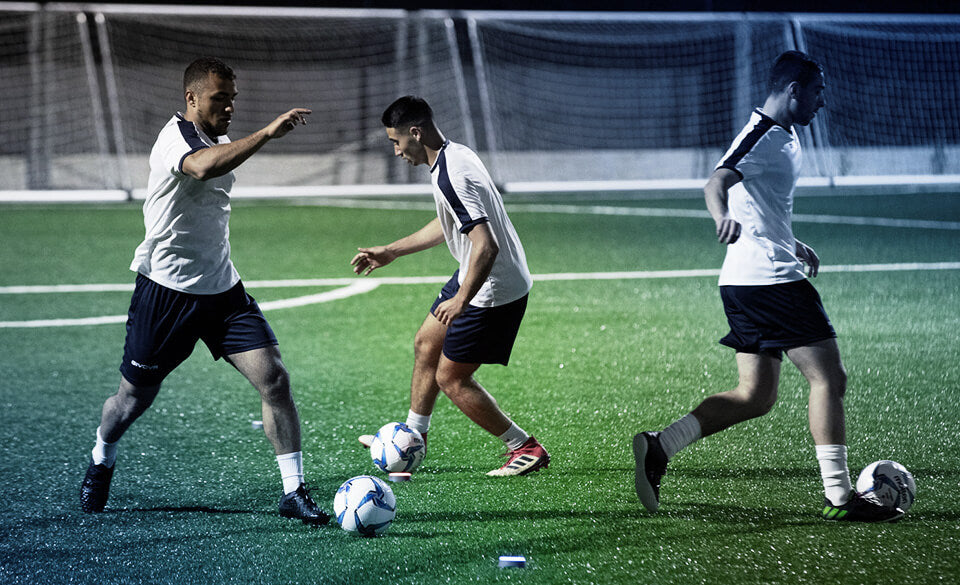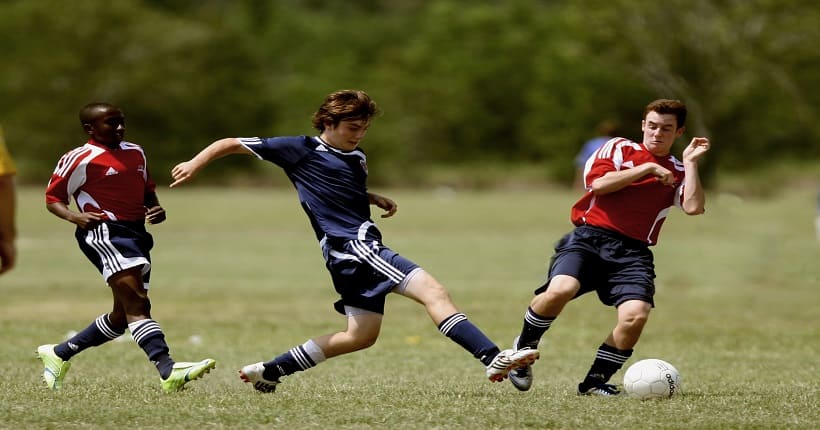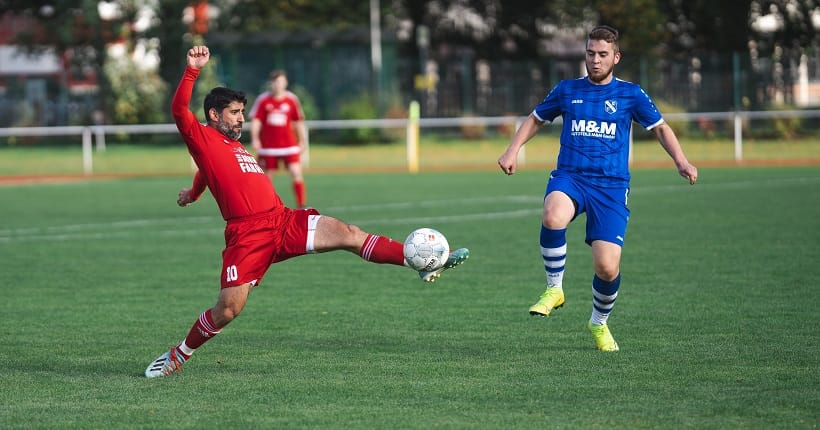How To Increase Stamina For Soccer?
To increase stamina for soccer, incorporate regular cardiovascular exercises and interval training into your workout routine. Soccer requires players to have high levels of endurance and stamina to keep up with the fast-paced nature of the game.
Strengthening your stamina will allow you to maintain a high energy level throughout the match, increase your speed, and recover quickly between sprints. By implementing a combination of cardiovascular exercises, such as running and cycling, along with interval training that alternates between high-intensity bursts and periods of rest, you can improve your overall endurance for soccer.
Additionally, focusing on proper nutrition, hydration, and getting enough rest will support your stamina-building efforts.
The Importance Of Stamina In Soccer
The Role Of Stamina In Soccer Performance
In the fast-paced and physically demanding game of soccer, stamina plays a crucial role in determining a player’s performance on the field. Stamina, also known as endurance, refers to the ability to sustain prolonged physical activity without experiencing fatigue. It is not only important for lasting the entire 90 minutes of a match but also for maintaining consistent performance throughout the game. Stamina enables soccer players to cover more ground, make quick sprints, and react swiftly to the constantly changing dynamics of the game.
How Stamina Affects Endurance, Speed, And Agility In Soccer Players
Endurance: Stamina directly impacts a player’s endurance levels in soccer. With increased stamina, players can continue running, sprinting, and engaging in intense physical movements for extended periods. This allows them to make important contributions to the team’s gameplay until the final whistle.
Speed: Stamina also affects a player’s speed on the field. When a player has good stamina, they can maintain a high level of speed and acceleration throughout the game. This enables them to cover more ground, chase after balls, and reach critical positions on the field in a timely manner.
Agility: Agility, which refers to the ability to change direction quickly and maintain balance, is influenced by stamina as well. Soccer players with high stamina levels can exhibit better agility, allowing them to navigate past opponents, make rapid turns, and execute quick and precise movements with ease.
Why Developing Stamina Is Crucial For Overall Game Performance
Developing stamina is of utmost importance for soccer players aiming to enhance their overall game performance. Without adequate stamina, players may struggle to keep up with the physical demands of the game and may experience fatigue early on. This can lead to decreased performance, reduced accuracy in passing and shooting, slower reaction times, and an increased risk of injuries. However, by consistently working on their stamina through specific training exercises and maintaining a healthy lifestyle, players can improve their endurance levels, ultimately resulting in a more effective and impactful presence on the soccer field.
Building A Solid Foundation: Developing Aerobic Endurance
Incorporating Long-distance Running Into Your Training Routine
One of the most effective ways to increase stamina for soccer is by incorporating long-distance running into your training routine. Running helps develop cardiovascular endurance, which is crucial for staying energetic throughout the game. By gradually increasing the distance of your runs, you can enhance your body’s ability to utilize oxygen efficiently, leading to improved stamina on the field.
Interval Training For Improving Cardiovascular Fitness
Interval training is another excellent method to boost cardiovascular fitness and enhance your stamina for soccer. This training technique involves alternating between high-intensity exercises and short recovery periods. By pushing your body to its limits during the intense bursts and then allowing it to recover, you can significantly improve your cardiovascular system’s efficiency. This translates to increased stamina and endurance during matches. Incorporate interval training sessions into your regular workouts to reap the maximum benefits.
Cross-training Exercises To Enhance Stamina And Prevent Boredom
Engaging in cross-training exercises is a great way to enhance stamina while also preventing boredom. Cross-training involves participating in various physical activities that complement soccer training. Not only does this help avoid overuse injuries, but it also targets different muscle groups and improves overall fitness. Some excellent cross-training exercises to consider include cycling, swimming, and strength training.
The Benefits Of Swimming And Cycling For Building Aerobic Endurance
Swimming and cycling are two low-impact activities that can immensely contribute to building aerobic endurance for soccer. Swimming is a full-body exercise that engages multiple muscle groups while providing a cardiovascular workout. It improves lung capacity, strengthens the heart, and promotes greater stamina on the field.
Cycling, on the other hand, is a fantastic way to develop leg strength and endurance. It helps increase cardiovascular fitness without putting excessive strain on the joints. Incorporating swimming and cycling into your training routine can provide the necessary variety and boost stamina for soccer.
| Benefits of Swimming | Benefits of Cycling |
|---|---|
|
|
Powering Through: Building Anaerobic Stamina
High-intensity Interval Training (hiit) For Building Anaerobic Stamina
When it comes to increasing your stamina for soccer, one effective method is high-intensity interval training (HIIT). This type of training involves alternating between short, intense bursts of exercise and brief recovery periods. By pushing your body to its limits and then allowing it to recover, HIIT helps build anaerobic stamina, which is crucial for those explosive moments on the field.
During HIIT sessions, you can incorporate various exercises such as sprints, shuttle runs, and agility drills. These activities simulate the intensity and demands of a soccer match, helping you develop the stamina needed to power through those crucial moments in the game where explosive bursts of energy are required.
Plyometric Exercises To Improve Explosive Power And Stamina
Another effective way to build anaerobic stamina for soccer is through plyometric exercises. Plyometrics focus on explosive movements, helping to improve both your power and stamina. These exercises involve quick, forceful movements that engage multiple muscle groups simultaneously.
Examples of plyometric exercises include box jumps, squat jumps, and lateral bounding. These movements not only strengthen your lower body but also improve your overall coordination, agility, and stability. By incorporating plyometrics into your training routine, you’ll be able to enhance your explosive power on the field and maintain your stamina during intense game situations.
Incorporating Circuit Training Into Your Workout Routine
Circuit training is another excellent method to enhance your anaerobic stamina for soccer. This type of training involves performing a series of exercises back-to-back with minimal rest in between. By continuously challenging your body and moving from one exercise to the next, circuit training helps improve your overall endurance and stamina.
When designing your soccer-specific circuit training routine, focus on exercises that target various muscle groups and replicate the demands of the game. This can include activities such as burpees, kettlebell swings, and shuttle runs. By regularly integrating circuit training into your workout routine, you’ll see improvements in your stamina, endurance, and ability to sustain high-intensity efforts throughout the match.
The Benefits Of High-intensity Resistance Training For Stamina Development
High-intensity resistance training is a valuable addition to any soccer player’s stamina-building arsenal. This form of exercise, which involves using heavy weights and performing fewer repetitions, helps you develop muscular strength and power, directly translating to improved stamina on the field.
When engaging in high-intensity resistance training, focus on compound exercises like squats, deadlifts, and bench presses. These movements engage multiple muscle groups simultaneously, mimicking the functional demands of soccer. By progressively increasing the weights and intensity of your resistance training workouts, you’ll not only build muscular strength but also enhance your stamina and endurance, allowing you to sustain high-level performance throughout the entire match.

Credit: www.blazepod.com
Fueling Your Performance: Proper Nutrition For Enhanced Stamina
To excel in soccer, it’s crucial to equip your body with the right fuel. Proper nutrition plays a vital role in enhancing stamina, ensuring you perform at your best throughout the game. In this article, we’ll delve into the key aspects of fueling your performance, namely the role of carbohydrates, optimal protein intake, the importance of hydration, and pre- and post-match meal ideas.
The Role Of Carbohydrates In Providing Energy For Soccer Players
Carbohydrates act as the primary source of energy for soccer players. They are crucial for maintaining stamina and fueling intense bursts of activity on the field. When consumed, carbohydrates are broken down into glucose, which is stored in our muscles and liver as glycogen. During exercise, our body taps into these glycogen stores to power our movements.
To ensure optimal energy levels during a game, your daily carbohydrate intake should be between 6-10 grams per kilogram of body weight. Incorporate complex carbohydrates such as whole grains, fruits, and vegetables into your diet. These provide sustained energy and are packed with essential nutrients that support overall performance.
Optimal Protein Intake For Muscle Repair And Recovery
While carbohydrates provide the energy, protein is essential for muscle repair and recovery. The high-intensity nature of soccer places significant stress on your muscles. Therefore, consuming adequate protein is crucial to aid in repairing any muscle damage and promoting proper recovery.
The recommended protein intake for soccer players varies depending on factors such as body weight, training load, and goals. As a general guideline, aim for 1.2-2.0 grams of protein per kilogram of body weight. Good sources of protein include lean meats, poultry, fish, eggs, dairy products, legumes, and plant-based protein sources like tofu and tempeh.
The Importance Of Hydration For Maintaining Stamina During Matches
Staying hydrated is paramount for maintaining stamina and peak performance on the soccer field. Dehydration can lead to decreased concentration, fatigue, and impaired physical performance. It’s important to hydrate before, during, and after matches to replenish fluid levels and prevent dehydration.
Aim to drink water throughout the day to ensure you’re adequately hydrated, and pay extra attention to hydration in the hours leading up to a game. During matches, take regular water breaks to replace lost fluids. Electrolyte-rich sports drinks can be beneficial, especially during prolonged bouts of exercise where electrolyte balance is crucial.
Pre- And Post-match Meal Ideas For Maximizing Stamina On Game Day
What you eat before and after a game can significantly impact your stamina. Pre-match, focus on consuming a balanced meal that includes carbohydrates for energy, lean protein for muscle repair, and healthy fats for sustained energy release. Here are some meal ideas:
- Wholegrain pasta with lean chicken and a side of roasted vegetables
- Oatmeal topped with fruits, nuts, and a dollop of Greek yogurt
- Quinoa salad with grilled salmon and leafy greens
After the match, prioritize replenishing your glycogen stores and aiding muscle recovery. Opt for a post-match meal or snack that combines carbohydrates and protein. Here are a few options to consider:
- Protein shake with a banana
- Grilled chicken wrap with whole wheat tortilla
- Lentil soup with a slice of whole grain bread
By fueling your body with the right nutrients, you can significantly enhance your stamina for soccer. Remember to consult with a sports nutritionist or dietitian to personalize your nutrition plan based on your specific needs and goals. With a well-rounded approach to nutrition, you’ll be well on your way to reaching your peak performance on the field.
Rest And Recovery: Essential For Stamina Enhancement
Rest and recovery play a crucial role in improving stamina for soccer players. While training and conditioning are essential, the body needs time to recuperate and repair itself. Adequate rest and recovery not only prevent injuries but also help athletes perform optimally. In this article, we will explore various aspects of rest and recovery that are essential for stamina enhancement in soccer. We will discuss the importance of adequate sleep, active versus passive recovery strategies, incorporating stretching and mobility exercises, and the role of relaxation techniques. By prioritizing rest and recovery, soccer players can improve their stamina and boost their overall performance on the field.
The Importance Of Adequate Sleep In Stamina Development
Sleep is often underrated when it comes to athletic performance, but it plays a crucial role in stamina development for soccer players. Getting enough quality sleep allows the body to repair and regenerate muscle tissues, strengthen the immune system, and replenish energy stores. Lack of sleep can lead to decreased reaction time, impaired cognitive function, and increased risk of injuries. The National Sleep Foundation recommends that adults aim for 7-9 hours of uninterrupted sleep per night. By prioritizing sleep, soccer players can enhance their stamina and overall performance.
Active Vs Passive Recovery Strategies For Soccer Players
When it comes to rest and recovery, soccer players have two main options: active and passive strategies. Active recovery involves low-intensity exercises such as light jogging, walking, or cycling, which help improve circulation, reduce muscle soreness, and flush out metabolic waste products. It promotes faster recovery and prepares the body for the next training session or game. On the other hand, passive recovery includes activities like stretching, foam rolling, cold or hot therapy, and massage. These techniques aid in relaxing the muscles, reducing inflammation, and promoting overall recovery. A combination of active and passive recovery strategies can help soccer players efficiently enhance their stamina.
Incorporating Stretching And Mobility Exercises Into Your Recovery Routine
Stretching and mobility exercises are vital components of a soccer player’s recovery routine. These exercises help maintain or improve joint mobility, flexibility, and muscular balance. Stretching exercises should be done both before and after training sessions to prevent muscle imbalances and increase range of motion. Incorporating dynamic stretches like lunges, leg swings, and hip rotations can help warm up the muscles, enhance blood flow, and decrease the risk of injuries. Additionally, including static stretches during the recovery phase can help reduce muscle stiffness and aid in overall recovery.
The Role Of Relaxation Techniques In Reducing Fatigue And Improving Stamina
Relaxation techniques can greatly contribute to reducing fatigue and improving stamina for soccer players. Practices like deep breathing exercises, meditation, and yoga help calm the mind, release tension, and improve focus. These techniques promote better sleep, reduce stress, and restore energy levels. By incorporating relaxation techniques into their routine, soccer players can effectively manage fatigue, improve their endurance, and maintain high stamina levels throughout the game.
Mental Conditioning: Strengthening Your Mind For Endurance
When it comes to increasing stamina for soccer, physical fitness training is often the focus. However, the importance of mental conditioning should not be overlooked. Strengthening your mind is key to improving your endurance on the field. With the right mindset, you can push past your limits and achieve peak performance even during prolonged matches. In this section, we will explore various techniques and strategies for mental conditioning that will help you enhance your stamina in soccer.
Developing Mental Toughness And Resilience For Prolonged Matches
Mental toughness is crucial for prolonged matches, where fatigue and pressure can take a toll on your performance. To develop mental toughness, you should cultivate resilience, which enables you to bounce back from setbacks and stay focused throughout the game. Here are some tips:
- Practice positive self-talk: During challenging moments, remind yourself of your abilities and strengths. Use affirmations to stay motivated and confident.
- Embrace discomfort: Endurance is all about pushing through discomfort. Embrace the physical and mental challenges that come with training and matches.
- Set small goals: Break down the match into smaller goals to maintain focus and track your progress. Achieving these smaller goals can boost your confidence and resilience.
Goal-setting And Visualization Techniques To Enhance Stamina
Setting clear goals and visualizing success can have a powerful impact on your stamina and endurance. Here’s how you can optimize goal-setting and visualization:
- Set specific and realistic goals: Define clear objectives that are achievable within a given timeframe. For example, aim to run an extra kilometer during each training session.
- Visualize success: Close your eyes and imagine yourself performing at your peak, maintaining stamina throughout the match. Visualization helps program your mind for success and enhances your belief in your abilities.
- Use imagery and mental rehearsal: Enhance your visualization with sensory details. Imagine the sound of the crowd, the feel of the ball at your feet, and the exhilaration of scoring a goal. Engage all your senses to make it more vivid.
Strategies For Managing Stress And Fatigue During Gameplay
Stress and fatigue can negatively impact your stamina during gameplay. It’s essential to develop strategies to manage these factors effectively. Here are some techniques to consider:
- Pace yourself: Recognize when you need to conserve energy throughout the match. Control your speed and exertion to avoid burnout early on.
- Breathing exercises: Focus on deep, rhythmic breathing to decrease stress levels and increase oxygen supply to your muscles. Practice diaphragmatic breathing during training sessions to improve your ability to relax and recover.
- Stay hydrated: Dehydration can lead to decreased stamina and performance. Drink water before, during, and after matches to stay properly hydrated.
- Take strategic breaks: Utilize substitutions and breaks during the game to rest and recover. Use this time wisely to refocus and reset mentally.
The Benefits Of Mindfulness And Meditation In Supporting Stamina Development
Mindfulness and meditation are effective practices for improving stamina in soccer. They can help you stay present, manage distractions, and maintain your energy level throughout the match. Consider incorporating these practices into your routine:
- Mindful breathing: Pay attention to your breath to anchor yourself in the present moment. This improves focus and allows you to conserve energy.
- Body scan meditation: Regularly scan your body from head to toe, releasing any tension or fatigue. This practice promotes relaxation and aids in recovery between strenuous activities.
- Visualization meditation: Combine visualization techniques with meditation to reinforce positive mental imagery. Envision yourself playing with stamina and endurance, further strengthening your belief in your capabilities.
By engaging in mental conditioning, focusing on resilience, goal-setting, stress management, and incorporating mindfulness and meditation practices, you can enhance your stamina for soccer. Remember, developing your mental fortitude is just as important as physical training when it comes to enduring prolonged matches and achieving your best performance.
Taking It To The Field: Implementing Stamina Training In Practice
When it comes to soccer, having a high level of stamina is essential for maintaining optimal performance throughout the match. In the previous sections, we discussed the importance of stamina training and provided individual exercises for players to build their endurance. Now, let’s take it to the field and explore how you can implement stamina training in practice sessions to maximize the overall stamina of your team.
Incorporating Stamina-specific Drills Into Team Training Sessions
In order to improve the stamina of the entire team, it is crucial to incorporate stamina-specific drills into your regular training sessions. These drills focus on building endurance, stamina, and recovery time, simulating the physical demands of a soccer match. Here are some examples of stamina-specific drills that you can introduce to your team:
- Interval training: Divide your players into groups and set up stations that involve different activities such as sprints, jogs, and recovery walks. Players must rotate through the stations, completing each activity for a set duration or distance.
- Circuit training: Create a circuit with various exercise stations and have players perform a series of exercises with minimal rest in between. This helps improve muscular endurance and cardiovascular fitness.
- Small-sided games: Modify the rules of a regular scrimmage by reducing the number of players, increasing the field size, or limiting the time available for each game. This increases the intensity and endurance demands on the players.
Individual Stamina Training Exercises For Players At Home
Individual players can also work on their stamina outside of team training sessions. As a coach, you can provide them with specific exercises to perform at home that target their cardiovascular fitness. Here are some individual stamina training exercises that players can incorporate into their routine:
- Long-distance runs: Encourage players to go for regular long-distance runs at a steady pace. This helps build endurance and improves the player’s ability to sustain effort over a longer period of time.
- Sprint intervals: Instruct players to perform short bursts of high-intensity sprints followed by periods of active recovery. This helps improve both their speed and stamina.
- Up-hill running: Find a hill in the vicinity and have players run uphill repeatedly. This increases the intensity of their workout and helps build strength and stamina.
Monitoring And Tracking Stamina Progress For Ongoing Improvement
Monitoring and tracking the stamina progress of your team and individual players is crucial for ongoing improvement. This allows you to identify strengths and weaknesses and adjust training programs accordingly. Here are some methods you can use to monitor and track stamina progress:
| Method | Description |
|---|---|
| Heart rate monitoring | Use heart rate monitors to measure players’ exertion levels during training sessions and games. This helps you assess their cardiovascular fitness and track improvements over time. |
| Time trials | Regularly conduct time trials to evaluate players’ speed and endurance. This provides an objective measure of their stamina progress. |
| Player feedback | Regularly communicate with players to gather feedback on their perceived effort levels and endurance during training sessions. This qualitative data can complement quantitative measurements. |
Integrating Stamina Training Into Your Overall Soccer Training Program
Now that you have an understanding of stamina-specific drills, individual stamina exercises, and monitoring methods, it is important to integrate stamina training into your overall soccer training program. By incorporating stamina training into your regular routines, you ensure that it becomes a part of the players’ holistic development. Here are some tips for integrating stamina training:
- Schedule dedicated stamina training sessions at least once a week, focusing on both team and individual exercises.
- Modify existing drills to include stamina-building elements, such as incorporating weight vests or reducing recovery time between repetitions.
- Regularly reassess players’ stamina levels to track progress and adjust training intensity or duration accordingly.
By implementing these strategies, you can effectively enhance the stamina of your team and individual players, leading to improved performance on the field. Remember, stamina training is not a one-time effort but an ongoing process that requires consistency and dedication. So, take it to the field and start implementing these stamina training techniques to take your soccer game to the next level!
Frequently Asked Questions On How To Increase Stamina For Soccer?
How Do I Build Stamina For Soccer?
To build stamina for soccer, focus on regular cardiovascular exercises like running, cycling, or swimming. Incorporate interval training to improve endurance and sprinting ability. Gradually increase workout intensity and duration for progressive improvement. Stay hydrated, maintain a balanced diet, and get sufficient rest to aid in recovery and optimize performance.
How Do You Last 90 Minutes In Soccer?
To last 90 minutes in soccer, focus on maintaining your stamina with proper fitness training, nutrition, and hydration. Pace yourself during the game, take short breaks during stoppages in play, and use strategic substitutions if available. Also, stay mentally focused and manage your energy levels effectively.
What Is The Fastest Way To Get Fitness For Soccer?
To quickly improve fitness for soccer, focus on high-intensity interval training, plyometric exercises, and agility drills. Incorporate aerobic exercises, such as running, and strength training to build endurance and power. Consistency, proper nutrition, and adequate rest are key to achieving optimal fitness results for soccer.
How To Improve Your Stamina?
To improve your stamina, engage in regular cardiovascular exercises like running or swimming. Gradually increase the duration and intensity of your workouts. Maintain a balanced diet rich in nutrients, stay hydrated, and incorporate strength training to build endurance. Get enough rest and sleep to allow your body to recover.
Stay consistent and motivated to see progress.
How Can I Increase My Stamina For Soccer?
Increasing your stamina for soccer can be achieved through consistent aerobic and anaerobic exercises, proper nutrition, and regular practice.
What Are The Best Exercises To Improve Soccer Stamina?
The best exercises to improve soccer stamina include interval training, running drills, high-intensity interval training (HIIT), and circuit training.
Conclusion
To enhance your soccer stamina, it’s crucial to adopt a well-rounded approach. By focusing on consistent training, incorporating interval workouts, fueling your body with nutritious foods, staying hydrated, and ensuring adequate rest, you can elevate your performance on the field.
Remember, building endurance takes time and dedication, so be patient and persistent in your pursuit. Boost your stamina and become an unstoppable force on the soccer field!







